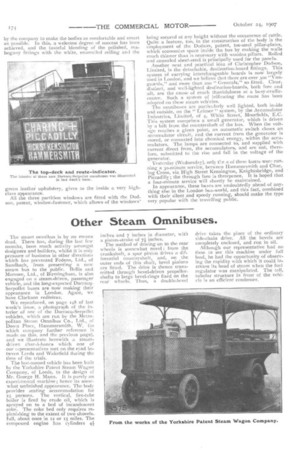New Steam Omnibuses in London.
Page 5

Page 6

If you've noticed an error in this article please click here to report it so we can fix it.
The Metropolitan, Steam Omnibus Company's Plans and Vehicles.
We published, in last week's issue, an interior view of London's newest motorbus, and, five weeks earlier, on page 8 of this volume, we gave a side view of the latest arrival on the streets of London. The fine Darracq-Serpollet vehicle shown in these prior illustrations is one of the first of its type to be worked in public service, and their running is of general interest.
The Metropolitan Steam Omnibus Company, Limited, of Down Place, Hammersmith, W., is the company which is running these vehicles, and its directors hope to have twenty such buses on the road before the end of November. The depot, at Down Place, off King Street, Hammersmith, W., is particularly well suited for use as a bus depat, although its capacity is not very great. There is, however, ample accommodation for at least twenty vehicles, and the arrangements for the storage of paraffin, for washing down the cars, and for easy means of ingress and egress, are equal to any we have seen even in larger depots.
The company's first object is to capture one route, and to make it pay. The route upon which it has begun will at least serve for training purposes. After that, expansion will follow as a matter of course and it will then become necessary to seek fresh quarters, where mote vehicles maybe housed. When that time arrives, a new depOt, specially laid out to meet the company's requirements, will be erected on a site which has been already decided upon.
The chassis for these steam buses are the now well-known Darracq-Serpollets, such as were described in our issue of the 26th of last month. The bodies are by Christopher Dodson Limited, of Westminster, Lambeth, and Camden Town, and are the last word—to date—in public-service body-work. Finished in dark-green, white, and gold, the vehicles are very smart in appearance, whilst the seating arrangement is quite novel and gives a degree of comfort and freedom no usually found in a public-service vehicle. The bus is ar. ranged to take 30 passengers, instead of the usual 34, ant the. seats are distributed equally inside and on the top-deck One need only refer to the illustration on page 148 of our last issue, to appreciate fully the convenient manner in which the 15 inside passengers are carried. The seating arrangement on the top-deck is equally convenient : there are five cross, or garden, seats, each of which holds three persons comfortably, and with a few inches over and above the /6 inches per person that is required by the Metropolitan Police Regulations. These seats are arranged centrally, so as to leave a gangway along each side, and an extrawide space behind the rear scat. There is thus plenty of room to allow passengers and conductor to pass each other.
The chassis arrangement has permitted increased overall bod, dimensions, without exceeding the 23 feet settled by the Metropolitan Police, and advantage \vas taken of this fact
by the company to make the bodies as comfortable and smart as possible. In this, a welcome degree of success has been achieved, and the tasteful blending of the polished, mahogany fittings with the white, enamelled ceiling and the
The top-,deck and route-indicator.
The interior of these new Darraeq•Serpollet ournibases was illustrated in last week's issue,
green leather upholstery, gives to the inside a very highclass appearance.
All the three partition windows are fitted with the Dodson, patent, window-fastener, which allows of the windows' being secured at any height without the occurrence of rattle. Quite a feature, too, in the construction of the body is the employment of the Dodson, patent, tee-steel pillar-plates, which economise, space inside the bus by making the walls much thinner than is necessary with wooden pillars. Rolled and annealed sheet-steel is principally used for the panels. Another neat and practical idea of Christopher Dodson, Limited, is the detachable, destination-board fittings. This system of carrying interchangeable boards is now largely used in London, and we believe that there are over 300 "Vanguards," and more than 2oo " Generals," so fitted. Clear, distinct, and well-lighted destination-boards, both fore and aft, are the cause of much thankfulness at a busy 'trafficcentre. Such a system of indicating the route has been adopted on these steam vehicles. The omnibuses are particularly well lighted, both inside and outside, on the " Lehner " system, by the Accumulator Industries, Limited, of 4, White Street, Moorfields, E.C. This system comprises a small generator, which is driven by a belt from the countershaft of the bus. When the voltage reaches a given point, an automatic switch closes an accumulator circuit, and the current from the generator is stored, or converted into chemical energy, within the accumulators. The lamps are connected to, and supplied with current direct from, the accumulators, and are not, therefore, submitted to the rise and fall in the voltage of the generator.
Yesterday (Wednesday), only ti-u%e of these bases wen, running a 30-minute service, between Hammersmith and Char_ ing Cross, via High Street Kensington, Knightsbridge, and Piccadilly ; the through fare is threepence. It is hoped that a four-minute service will shortly be maintained.
In appearance, these buses are undoubtedly ahead of anything else in the London bus-world, and this fact, combined with their silent and speedy running, should make the type very popular with the travelling public.


























